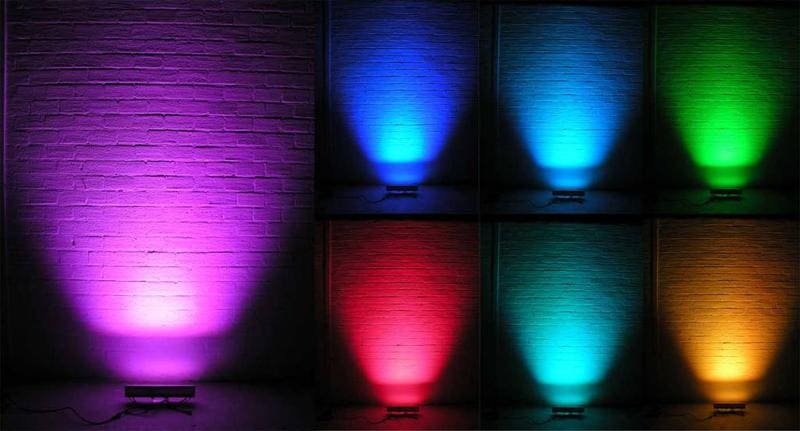А. Ключевая роль освещения в создании настроения и функциональности дома

Lighting plays a critical role in creating the right atmosphere and enhancing the functionality of different spaces in a home. Beyond aesthetics, lighting significantly affects how comfortable and practical a room feels. Whether it’s a cozy living room, a bright kitchen, or a focused workspace, the right lighting can make a substantial difference in how these areas are used. Lighting can emphasize architectural features, set the tone for activities, and impact the well-being of those who inhabit the space. For instance, warm lighting can help create a relaxing environment, while cooler, brighter lighting can energize a space for productivity.
B. The Impact of Color Temperature on the Atmosphere and Usability of Various Rooms
Color temperature is an essential factor in lighting design, as it directly influences the mood and usability of a room. Measured in Kelvins (K), color temperature ranges from warm, yellowish hues at lower Kelvin ratings (e.g., 3000K) to cooler, bluish tones at higher ratings (e.g., 6000K). Warm lighting, such as 3000K, is often used in areas meant for relaxation, such as living rooms and bedrooms, as it creates a cozy and intimate ambiance. In contrast, cooler lighting, like 4000K and 6000K, is more suitable for task-oriented spaces such as kitchens, bathrooms, and home offices. These cooler tones provide the clarity and brightness needed for activities requiring focus and precision.
C. Brief Overview of LED Lighting Options and Their Applications
LED lighting has become a popular choice for modern homes due to its energy efficiency, longevity, and versatility in color temperatures. LED lights are available in various color temperatures, making them suitable for different applications throughout the home. For instance, 3000K LED lights are ideal for creating warm, inviting environments in areas such as living rooms and dining spaces. Meanwhile, 4000K LEDs offer a neutral, natural light, perfect for spaces like kitchens and home offices where a balance between warmth and brightness is needed. Lastly, 6000K LEDs are commonly used in areas requiring high visibility and precision, such as workshops, garages, and outdoor settings.
Lighting Color Temperature Explained
A. Definition of Lighting Color Temperature
Lighting color temperature refers to the perceived hue or color of light emitted by a light source, typically measured in Kelvins (K). It determines whether the light appears warm, neutral, or cool, which directly influences the mood, ambiance, and functionality of a space. The concept of color temperature is crucial in both residential and commercial lighting applications as it helps in selecting the appropriate lighting for specific rooms and tasks. Different color temperatures can evoke varied emotional responses and affect the usability of spaces. For example, warmer temperatures can create a calming, cozy environment, while cooler temperatures are more stimulating and are often used in task-oriented areas.
B. The Kelvin Scale and Its Measurement of Light Hues
The Kelvin scale is used to measure the color temperature of light sources, providing a numerical value that corresponds to different shades of light. The scale begins around 1000K, representing a dim, orange-red hue, and extends upwards to 10,000K, indicating a bright, blue-white light akin to daylight on a clear afternoon. Lower values on the Kelvin scale (2700K-3000K) produce a warm, yellowish glow, while higher values (5000K-6500K) result in a cooler, bluish hue. Mid-range values, such as 4000K, offer a balance between warmth and coolness, closely resembling natural daylight. Understanding the Kelvin scale allows homeowners and designers to choose lighting that complements the functionality and desired atmosphere of a space.
C. Examples of Color Temperatures and Their Effects on Ambiance
- 2700K: Cozy and Warm with a Yellowish Glow
2700K is on the lower end of the Kelvin scale, offering a soft, warm light that creates a cozy and inviting atmosphere. Often associated with traditional incandescent bulbs, this color temperature emits a yellowish glow that is ideal for spaces where relaxation and comfort are prioritized. For example, living rooms, bedrooms, and dining areas can benefit from the soothing effect of 2700K lighting. This warmth helps to set a calm and intimate mood, making it perfect for spaces meant for unwinding or entertaining guests in a laid-back environment. Additionally, 2700K lighting can be used for accent lighting to highlight artwork or architectural details, adding depth and warmth to a room’s design.
- 4000K: Balanced Like Natural Daylight
At 4000K, the lighting takes on a more neutral tone, providing a balance between warmth and coolness. Often described as neutral white or cool white, 4000K lighting is comparable to the brightness and clarity of natural daylight. This makes it an ideal choice for areas of the home that require task-oriented lighting, such as kitchens, bathrooms, or home offices. The brightness of 4000K lighting allows for better focus and visibility, making it useful in spaces where attention to detail is necessary, such as cooking or working at a desk. Additionally, this color temperature is widely used in commercial settings, including retail stores, where clear and vibrant lighting is required to highlight products and ensure a professional appearance. The balance provided by 4000K lighting can also complement modern interior designs, creating a clean and crisp atmosphere without being overly harsh.
- 5000K and Above: Clinically Cool with a Bluish Tint
Once the color temperature reaches 5000K and above, the light begins to take on a cooler, bluish tint that is often described as “daylight” or “cool white.” This type of lighting is reminiscent of clear midday sunlight, making it highly effective for spaces that require a high level of brightness and visibility. With its crisp and clinical appearance, 5000K lighting is often used in industrial or commercial settings such as workshops, garages, and hospitals, where clarity and precision are paramount. In residential applications, 5000K lighting is typically reserved for spaces like basements, utility rooms, or outdoor areas where visibility is more important than ambiance. While this lighting can create a sterile and focused environment, it is less commonly used in areas meant for relaxation due to its stimulating and sometimes harsh effect on the eyes. The blue tint of 5000K lighting can also suppress melatonin production, making it less suitable for areas like bedrooms or living rooms where relaxation is the primary goal.
In summary, understanding the Kelvin scale and how different color temperatures affect ambiance can help homeowners make informed decisions when selecting lighting for their spaces. From the warm, cozy glow of 2700K to the bright, focused light of 5000K and above, choosing the right lighting temperature is essential in creating a functional and inviting home environment.
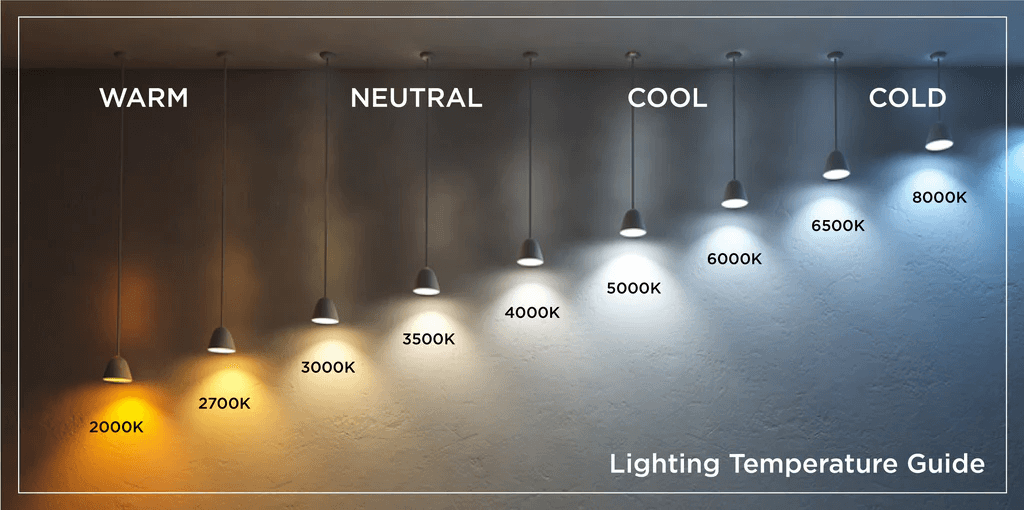
The Spectrum of Color Temperatures
A. Detailed List of Color Temperatures and Their Visual Characteristics
Understanding the various color temperatures and how they visually impact a space is essential for creating the right ambiance in any room. Color temperature, measured in Kelvins (K), defines the hue of light a bulb emits, ranging from warm, yellowish tones to cool, bluish shades. Each temperature has distinct characteristics and is suitable for specific environments.
- 2000K-2200K: Yellow – Ideal for Creating a Sleepy Atmosphere
The 2000K-2200K range emits a soft, yellow glow, resembling the warm flicker of candlelight or old-fashioned incandescent bulbs. This ultra-warm lighting is perfect for spaces designed for relaxation and winding down, such as bedrooms or lounges. Its sleepy, calming atmosphere promotes the production of melatonin, the hormone responsible for regulating sleep, making it ideal for late evening use. This lighting is often seen in restaurants, bars, or intimate home spaces where the goal is to evoke warmth and coziness.
- 2700K-3000K: Warm White – Comfortable for General Lighting
The 2700K-3000K range, commonly referred to as warm white, is widely used in residential lighting. This temperature is similar to traditional incandescent bulbs, offering a comfortable and inviting yellowish-white hue. Warm white lighting works well in living rooms, dining areas, and bedrooms, where it provides a cozy and relaxed environment. It is also a great option for general lighting purposes, as it feels natural without being too harsh or too dim. The soft glow of 2700K-3000K lighting makes it ideal for creating an atmosphere of comfort and warmth, fostering relaxation while still being functional.
- 3500K-4000K: Neutral White – A Mix of Warm and Cool Tones
The 3500K-4000K range, often called neutral white or cool white, is a balanced combination of warm and cool tones, providing a clean, natural look. This lighting resembles daylight, making it suitable for rooms that require clear visibility without the starkness of cooler lighting. Kitchens, bathrooms, and home offices benefit from this temperature range because it enhances focus without feeling too clinical. Neutral white lighting is a versatile option, giving spaces a modern, fresh look while maintaining a degree of warmth. It is commonly used in commercial environments as well, where natural clarity is essential but an overly cold atmosphere is not desired.
- 5000K-6000K: Cool White – Energizing and Good for Concentration
Lighting in the 5000K-6000K range emits a bright, cool white light with a slight bluish hue. Known for its energizing effect, this temperature is perfect for spaces where concentration and precision are key, such as offices, workspaces, and study areas. The cool white light boosts alertness and helps reduce eye strain during tasks that require attention to detail. However, because of its intensity, it can feel too harsh for relaxing areas like bedrooms or living rooms. Many people use this range for task lighting rather than ambient lighting, as it provides the clarity needed for work without creating a comfortable, homey environment.
- 6500K-8000K: Cold White (Daylight) – Maximum Clarity for Tasks
At the highest end of the spectrum, 6500K-8000K lighting emits a bluish-white light known as daylight or cold white. This temperature is often compared to natural daylight at noon and is ideal for areas requiring maximum brightness and clarity. Spaces like garages, workshops, laboratories, and outdoor settings benefit from this lighting due to its ability to enhance visibility and attention to detail. In residential use, 6500K-8000K lighting is typically reserved for task-specific environments, as it can feel too sterile for most home settings. While excellent for productivity, this light may cause discomfort if used in spaces meant for relaxation.
B. How Different Color Temperatures Can Enhance or Detract from a Room’s Atmosphere
Color temperature plays a crucial role in setting the mood and functionality of a room. Selecting the right color temperature can enhance the atmosphere of a space, making it more welcoming, functional, or energizing, depending on its intended use. Conversely, choosing the wrong color temperature can detract from the desired mood and negatively impact the room’s usability.
For example, in living rooms and bedrooms, warmer temperatures (2000K-3000K) create a cozy, intimate setting that promotes relaxation and unwinding. Using overly cool lighting in these spaces can feel stark and uninviting, disrupting the comfort of the room. On the other hand, cooler temperatures (5000K-6000K) are beneficial in kitchens, bathrooms, and offices, where bright, clear light is needed to see details clearly and stay focused. However, if the lighting is too warm in these areas, it can make the space feel dim and reduce productivity.
Balancing the color temperature with the room’s function is essential for optimizing both comfort and efficiency. Warmer lights help in spaces meant for relaxation, while cooler lights are better suited for areas of activity, focus, and precision. Understanding these effects allows for more intentional and effective lighting choices.
Важность температуры освещения
A. The Psychological Effects of Lighting on Mood and Behavior
Lighting temperature has a profound impact on human psychology, influencing emotions, behavior, and even productivity. Warmer lighting (typically around 2700K-3000K) has been shown to promote relaxation and comfort, creating a sense of intimacy and tranquility. This is why it is often used in spaces where winding down or socializing is encouraged, such as living rooms, bedrooms, and dining areas. The soft, yellowish hues associated with warm lighting stimulate the production of melatonin, a hormone that helps regulate sleep cycles. As a result, these lighting conditions can help the body prepare for rest and reduce stress levels.
In contrast, cooler lighting (4000K-6000K), with its brighter and bluer tones, is stimulating and energizing. It can increase alertness and concentration, making it ideal for environments where productivity is key. Offices, kitchens, and workspaces often benefit from cool lighting, as it encourages focus and sharpens mental clarity. However, overexposure to very cool lighting, especially in the evening, can suppress melatonin production, potentially leading to difficulty sleeping and increased stress. Therefore, selecting appropriate lighting temperatures is essential for maintaining a healthy balance in mood and behavior, depending on the purpose of the space.
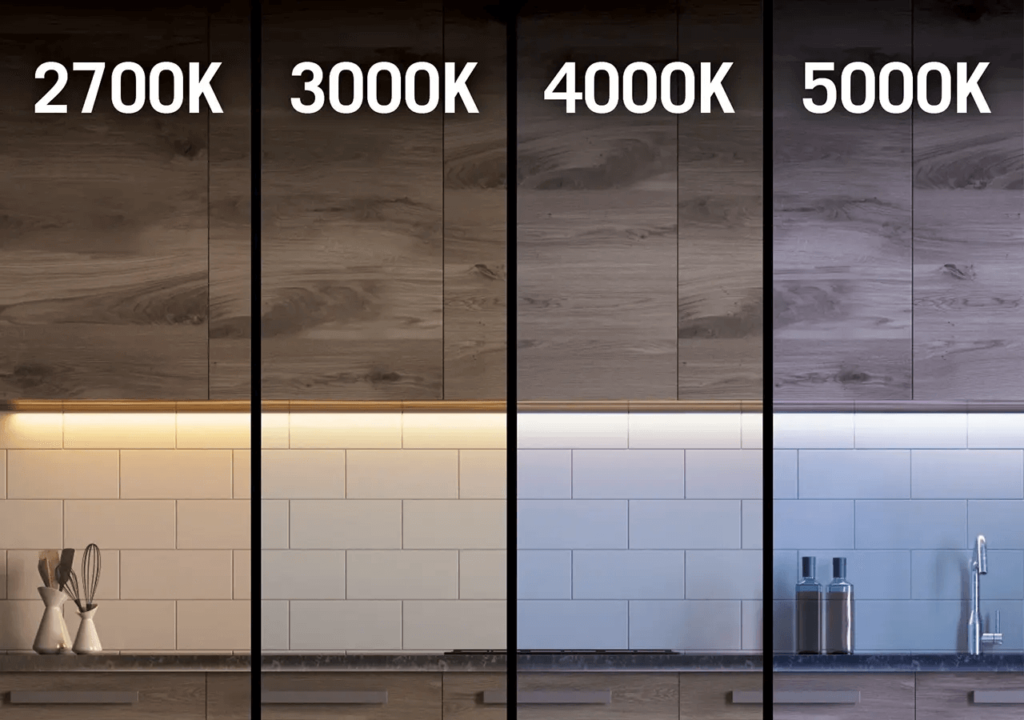
B. Practical Considerations for Different Rooms and Activities
The choice of lighting temperature should align with the specific functions of a room and the activities performed there. For example, warm lighting (2700K-3000K) is ideal for spaces designed for relaxation, such as bedrooms, living rooms, and dining rooms. The cozy glow helps foster an inviting and restful atmosphere, perfect for winding down after a long day.
Neutral lighting (3500K-4000K) strikes a balance between warmth and brightness, making it suitable for areas like kitchens, bathrooms, and home offices. These spaces require enough light for visibility and task completion, but the tone is not too harsh. Neutral lighting offers clarity without the starkness of cool lighting, making it versatile for rooms that serve multiple functions.
Cool lighting (5000K-6000K) is often reserved for spaces that require high visibility and focus, such as workspaces, garages, and outdoor areas. It is also used in environments where accuracy and attention to detail are critical, like laboratories or art studios. While cool lighting can be harsh if overused, it is necessary for tasks that demand concentration and precision.
C. The Concept of Layering Lighting for Versatile Ambiances
Layering lighting is a crucial strategy for achieving versatility and depth in a room’s ambiance. This concept involves combining different lighting types—ambient, task, and accent lighting—to create a balanced and functional lighting design that adapts to various needs and moods.
Ambient lighting serves as the room’s primary light source, usually provided by overhead fixtures. Its color temperature should be chosen based on the room’s overall purpose; for instance, warmer lighting for a living room or cooler lighting for a workspace. Task lighting, such as under-cabinet lights in a kitchen or reading lamps in a study, provides focused illumination for specific activities. This layer often benefits from cooler lighting, as it enhances visibility and reduces eye strain. Accent lighting, such as spotlights or decorative lamps, adds warmth, depth, and visual interest to a room. Typically, accent lighting is softer and warmer, highlighting architectural features or art pieces without overwhelming the space.
By layering these different lighting types and temperatures, homeowners can create flexible environments that cater to various functions and moods. For example, dimmable lights or adjustable fixtures can transition a space from bright, task-oriented lighting to a more relaxed and intimate setting, providing a wide range of ambiance options throughout the day. This adaptability makes lighting temperature and layering essential considerations in modern interior design.
Выбор правильного освещения для вашего дома
Lighting plays a critical role in shaping the ambiance, functionality, and energy efficiency of your home. By selecting the right lighting temperature, you can create an atmosphere that suits each room’s specific needs. Here’s an in-depth look at the factors that influence lighting choices and some strategies to experiment with different color temperatures.
A. Factors Influencing the Choice of Lighting Temperature
1. Room Purpose The primary factor in choosing the right lighting temperature is the purpose of the room. Every space in your home serves a different function, and lighting should complement those functions:
- Living rooms and bedrooms often benefit from warmer lighting (around 3000K), which creates a cozy, relaxing atmosphere conducive to unwinding after a long day.
- Kitchens and home offices require brighter, cooler lighting (4000K) for clarity and focus, making it easier to work or prepare meals with precision.
- Bathrooms often need a combination of lighting. For instance, cool lighting near mirrors helps with grooming, while softer lighting elsewhere maintains a relaxing ambiance.
- Garages and basements may require the brightest and coolest lighting, such as 6000K, to ensure visibility during detailed tasks like car repairs or crafts.
Matching the lighting temperature to the room’s specific purpose ensures both comfort and efficiency in everyday tasks.
2. Desired Ambiance Lighting temperature significantly impacts the ambiance of a room. A warm color temperature (3000K or lower) creates an inviting, intimate mood, ideal for spaces like living rooms, bedrooms, or dining areas where comfort is prioritized. Conversely, cooler color temperatures (4000K and higher) offer a cleaner, more energetic atmosphere that works well in areas where productivity is key, such as home offices or kitchens. The choice of lighting color directly affects how a room feels—soft and relaxing or bright and energizing.
3. Energy Efficiency Energy efficiency is another essential consideration when choosing lighting. LED lights are a top choice for energy savings because they use significantly less power than traditional incandescent bulbs. When choosing lighting temperatures, consider that cooler lighting options tend to be slightly more energy-efficient than warmer ones due to their composition. That said, the difference is minimal, and personal preference often outweighs this slight energy advantage. LED lights, in general, provide a balance between energy conservation and long-term cost savings, as they have a longer lifespan than other types of bulbs.

B. The Role of Personal Preference in Lighting Selection
While functionality and ambiance are crucial, personal preference plays a substantial role in lighting choices. Everyone has different sensitivities to light. For instance, some people may find cooler lighting (4000K to 6000K) too harsh for residential spaces, preferring the soft warmth of 3000K lighting, even in task-heavy rooms like kitchens or offices. Likewise, those who prefer a minimalist, modern aesthetic might opt for the cleaner look of cool lighting in their living spaces, despite the traditional suggestion of warmer tones. Personal taste, comfort, and the overall style of your home are key to finalizing your lighting decisions.
C. Strategies for Experimenting with Different Color Temperatures
When determining the best lighting temperature for your home, it’s essential to experiment with various options. Here are some strategies to find what works best:
- Use dimmable LED bulbs: Dimmable lights allow you to change the intensity of lighting to suit different moods and tasks. They also provide a way to shift between cooler and warmer tones if you select tunable LED lights, offering greater flexibility in a single fixture.
- Try adjustable or tunable LEDs: Some modern LED fixtures allow you to adjust the color temperature itself, switching between warmer, neutral, or cooler tones. This is ideal for spaces that serve multiple purposes, such as a home office that also functions as a relaxation area in the evening.
- Test lighting in different rooms: Since lighting impacts mood and functionality, try placing bulbs with different color temperatures in various rooms. For example, start with warm lighting in your living room and cooler lighting in your bathroom or kitchen. Over time, observe how these temperatures affect your comfort and productivity in each space.
- Consider layering your lighting: Layered lighting, which includes ambient, task, and accent lighting, allows you to blend different color temperatures to create a more dynamic and versatile space. For instance, you might use warm lighting for ambient light but cooler task lighting in work zones, giving you the best of both worlds.
3000K Lighting Color Temperature
A. Characteristics of 3000K Lighting: Warm, Inviting, and Relaxing
Lighting with a color temperature of 3000K is known for its warm, inviting, and relaxing characteristics. It emits a soft, yellowish-white hue that mimics the warmth of traditional incandescent bulbs. This temperature falls on the warmer side of the Kelvin scale, creating an ambiance that feels cozy and soothing. The subtle glow of 3000K lighting is ideal for fostering a sense of comfort, making it an excellent choice for spaces designed for relaxation and socializing. This lighting temperature is particularly effective in softening the look of a room, giving it a welcoming and intimate atmosphere that encourages people to unwind and feel at ease.
Unlike cooler lighting, which can feel sterile or too bright, 3000K lighting adds warmth to a space without overwhelming it. It strikes a balance between brightness and softness, providing enough illumination for everyday activities while maintaining a calming, homey feel. This quality makes it one of the most popular choices for residential lighting, as it enhances the natural warmth of materials like wood, fabric, and other organic textures, helping to create a harmonious, peaceful environment.
B. Advantages: Ideal for Socializing and Winding Down
One of the primary advantages of 3000K lighting is its ability to foster a relaxing and sociable environment. Its warm, soft glow is perfect for areas where people gather, such as living rooms, dining rooms, and bedrooms. In these spaces, the inviting quality of 3000K lighting encourages relaxation and comfort, making it easier to unwind after a long day or enjoy meaningful conversations with family and friends.
Additionally, the warm tones of 3000K lighting are known to have a calming effect on the body and mind. This lighting temperature helps to reduce stress and can even promote the production of melatonin, a hormone that regulates sleep cycles. As a result, it is often used in bedrooms or areas where winding down is important, such as reading nooks or living spaces. The soft light creates an intimate atmosphere that encourages a sense of peace, making it perfect for evening relaxation or social gatherings.
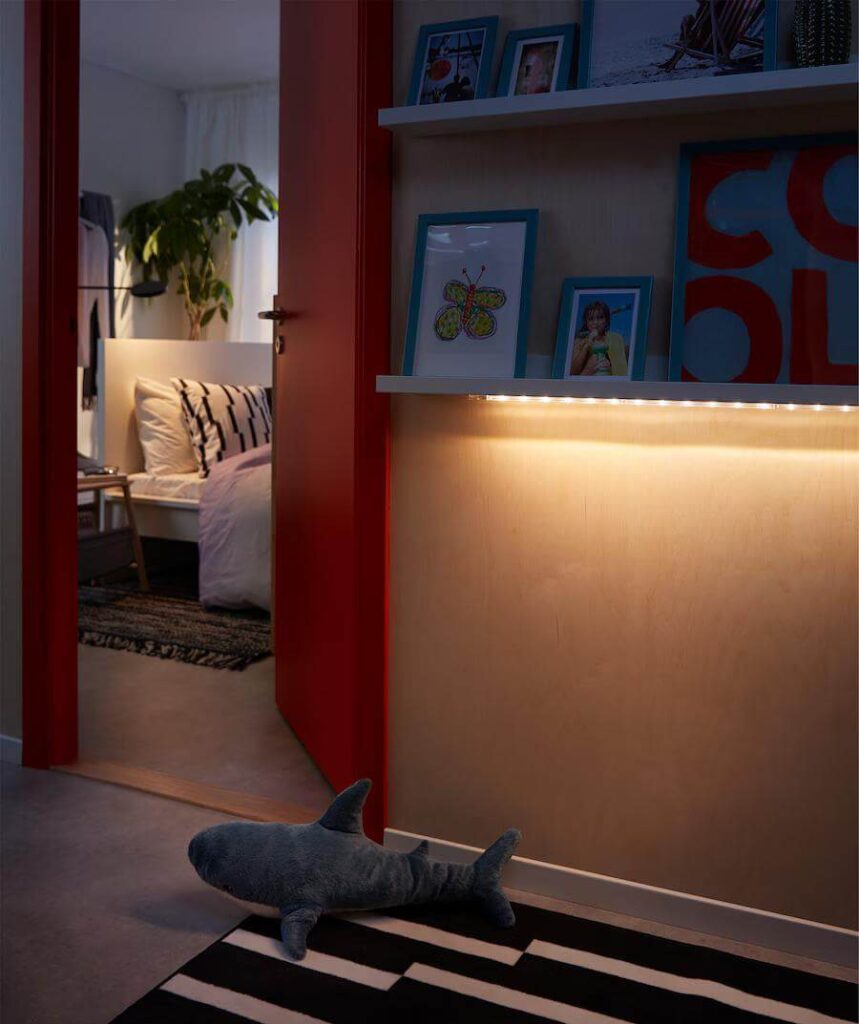
C. Disadvantages: May Lack Brightness for Detailed Tasks
While 3000K lighting excels in creating a warm and comfortable environment, it may not provide sufficient brightness for tasks that require a high level of detail or focus. For example, in spaces where precision and clarity are essential—such as kitchens, home offices, or bathrooms—3000K lighting may feel too dim or yellowish, making it harder to see clearly. This is especially true for tasks like cooking, working at a desk, or applying makeup, where brighter, cooler lighting is often preferred to ensure accuracy and reduce eye strain.
The soft and cozy nature of 3000K lighting can also be less effective in spaces that need to feel energizing or productive. For instance, in a home office or workshop, where focus and concentration are key, warmer lighting may not provide the sharpness needed to maintain alertness. In these environments, cooler lighting temperatures (like 4000K or 5000K) are often more suitable because they offer a brighter, clearer light that enhances visibility and helps improve focus.
D. Suitable Areas: Bedrooms, Living Rooms, Dining Areas, and Accent Lighting
3000K lighting is especially well-suited for areas in the home where relaxation, comfort, and social interaction are priorities. Bedrooms are an ideal location for 3000K lighting, as the warm glow helps create a peaceful, calming environment conducive to rest and sleep. In living rooms, this lighting temperature provides a cozy ambiance, making the space perfect for unwinding or entertaining guests. Similarly, dining rooms benefit from the inviting and intimate atmosphere that 3000K lighting creates, setting the perfect mood for shared meals and conversations.
In addition to general lighting, 3000K bulbs are also commonly used for accent lighting. Whether highlighting artwork, or architectural features, or creating a warm glow in alcoves and bookshelves, 3000K lighting adds depth and warmth to specific areas of a room. This makes it a versatile option for adding visual interest and enhancing the aesthetic appeal of a space without overpowering the main lighting scheme.
E. Comparison to Incandescent Bulbs and Other Warm-Toned Lighting
3000K lighting is often compared to traditional incandescent bulbs, as both share a similar warm, yellowish hue. Incandescent bulbs, which typically have a color temperature of around 2700K, are known for their soft, warm light that has been a household staple for decades. While incandescent bulbs offer a slightly warmer and more yellowish tone than 3000K LED bulbs, the two lighting options produce a similar effect in terms of creating a cozy and inviting atmosphere.
However, 3000K LED bulbs have several advantages over incandescent lighting. LEDs are far more energy-efficient, lasting significantly longer and consuming less power. This makes them a more sustainable and cost-effective option for homeowners who want to maintain a warm lighting aesthetic without the drawbacks of traditional incandescent bulbs, such as their shorter lifespan and higher energy consumption. Additionally, LED technology allows for greater flexibility in terms of dimming and color variation, giving users more control over the ambiance of their space.
Compared to other warm-toned lighting options, 3000K LEDs provide a middle ground between the ultra-warm hues of 2700K and the cooler tones of 4000K. This makes 3000K a versatile choice that balances the warmth of traditional lighting with the clarity needed for modern living spaces. While 2700K lighting may be too dim for some areas and 4000K too bright or clinical, 3000K offers the perfect compromise for creating a welcoming, comfortable environment in a variety of settings.
4000K Lighting Color Temperature
A. Characteristics of 4000K Lighting: Clean, Bright, and Modern
4000K lighting, often referred to as cool white or neutral white, is known for its clean and bright illumination. Falling between the warmer yellow tones of 3000K and the cooler blue hues of 5000K, 4000K emits a balanced light that combines the best of both worlds. It is neither too warm nor too cold, providing a neutral appearance that closely resembles natural daylight. This temperature offers a crisp, modern look that enhances visibility and provides excellent clarity, making it highly suitable for spaces where tasks requiring precision and focus are common.
Visually, 4000K lighting produces a clear, white light that brightens spaces without creating the yellowish tint associated with warmer lights or the stark blue tone of cooler ones. Its neutral color palette complements both traditional and contemporary design styles, making it a versatile choice for a wide variety of environments. Because of its brightness and clarity, 4000K lighting enhances the overall aesthetic of a space, making it feel open, airy, and fresh. This modern, clean quality makes it ideal for environments that demand a high level of visual accuracy or where a sleek, minimalist look is desired.
B. Advantages: Excellent for Tasks Requiring Attention to Detail
One of the primary advantages of 4000K lighting is its suitability for tasks that require precision and attention to detail. This color temperature is bright enough to illuminate spaces effectively, ensuring that small details are clearly visible, whether you’re cooking, working at a desk, or grooming in the bathroom. The bright, neutral light of 4000K reduces eye strain and improves focus, making it an excellent option for areas where clarity is crucial.
For instance, in kitchens, where accurate color rendition is important for preparing food, the crisp light provided by 4000K bulbs ensures that ingredients are easy to see and work with. Similarly, in home offices, this temperature is ideal for reading, writing, and working on a computer, as it enhances visibility without causing the harsh glare associated with cooler lights. Additionally, bathrooms benefit from 4000K lighting, where tasks like shaving or applying makeup demand accurate lighting to avoid shadows or distortions.
4000K lighting is also highly versatile. It works well in commercial settings, such as offices, retail stores, and hospitals, where focus and productivity are critical. The bright, clean light helps people stay alert and concentrated, making it a practical choice for workspaces and areas where efficiency is important.
C. Disadvantages: May Feel Too Clinical or Harsh in Some Settings
Despite its many advantages, 4000K lighting may feel too clinical or harsh in certain settings. Because of its bright, neutral quality, this temperature can sometimes create an overly sterile or impersonal atmosphere, which might not be suitable for spaces intended for relaxation or leisure. In rooms like living rooms or bedrooms, where a cozy, inviting ambiance is desired, 4000K lighting can feel cold and unwelcoming.
The neutrality of 4000K lighting can also lack the warmth and intimacy that some environments benefit from. For example, in dining areas or family rooms, this lighting may feel too harsh, making it less conducive to creating a comfortable or intimate atmosphere. Additionally, prolonged exposure to cooler lighting can cause eye fatigue and discomfort in spaces meant for relaxation, making it less ideal for areas where people unwind after a long day.
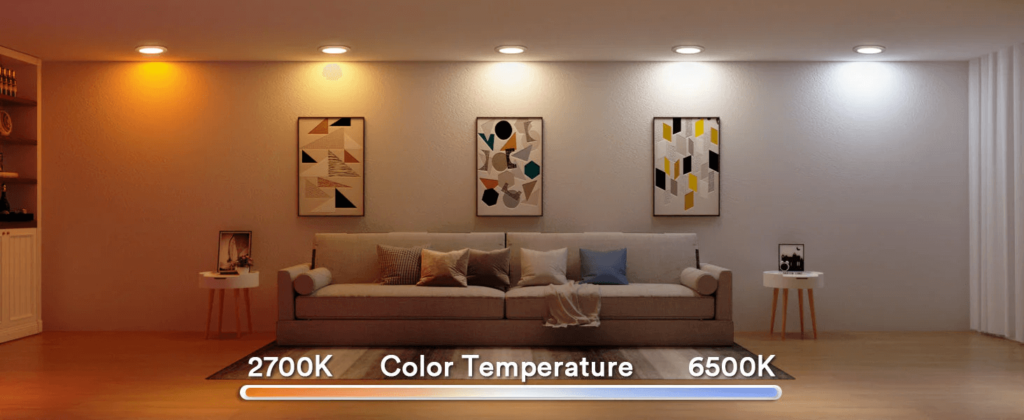
D. Suitable Areas: Kitchens, Bathrooms, Home Offices, and Entryways
4000K lighting is particularly well-suited for functional spaces in the home where clarity and brightness are essential. Kitchens are an ideal environment for 4000K lighting, as this temperature offers the perfect blend of brightness and color accuracy for food preparation and cooking. The clean, white light enhances visibility, allowing for better safety and efficiency in this highly utilized area.
Bathrooms also benefit from 4000K lighting, especially around mirrors where detailed grooming tasks, such as shaving or applying makeup, require optimal lighting conditions. The bright, neutral light reduces shadows and provides a clear reflection, ensuring that tasks are done with precision.
In home offices, 4000K lighting fosters productivity and focus. Its bright and clear light helps reduce eye strain during extended periods of reading, writing, or working on the computer, making it a practical choice for workspaces. Moreover, entryways benefit from the clean, welcoming look of 4000K lighting, ensuring that these transitional spaces are well-lit and inviting without feeling overly warm or dim.
E. The Role of 4000K Lighting in Contemporary Interior Design
4000K lighting has become a staple in contemporary interior design, largely due to its ability to create a bright, modern atmosphere. The neutral white light complements the minimalist and sleek aesthetics that define modern interiors. In spaces dominated by clean lines, neutral colors, and open layouts, 4000K lighting enhances the sharpness of architectural features and ensures that rooms feel spacious and bright.
This lighting temperature pairs well with contemporary materials such as glass, metal, and concrete, all of which benefit from the clarity and brightness that 4000K lighting provides. Its ability to highlight the texture and details of these materials makes it an excellent choice for kitchens with stainless steel appliances, modern bathrooms with chrome fixtures, and living spaces with large windows and natural elements. The neutral hue of 4000K lighting also ensures that it doesn’t interfere with or distort the colors of furnishings and décor, preserving the integrity of interior design choices.
Additionally, 4000K lighting is often used in combination with other lighting temperatures to create layered lighting schemes in modern homes. For example, while 4000K serves as an excellent task light in kitchens or bathrooms, it can be complemented with warmer 3000K lighting in living or dining areas to create a balanced atmosphere that shifts between different moods and functions. The versatility and balance that 4000K lighting offers make it a key component in contemporary design, where functionality meets aesthetics.
In conclusion, 4000K lighting is an excellent choice for spaces requiring bright, clean, and modern light. While it may not be ideal for every room, its ability to provide clarity and enhance focus makes it invaluable in kitchens, bathrooms, offices, and other task-oriented spaces. When thoughtfully incorporated into a design plan, 4000K lighting contributes significantly to the functionality and aesthetic appeal of contemporary homes and commercial environments.
6000K Lighting Temperature
A. Characteristics of 6000K Lighting: Bright, Crisp, and Daylight-Like
6000K lighting is characterized by its intense brightness, crisp white tones, and resemblance to natural daylight. Falling on the higher end of the Kelvin scale, it emits a cool, bluish-white light that mimics the feel of daylight during midday, making it ideal for environments where clear, focused lighting is essential. This type of lighting is often referred to as “cool white” or “daylight” due to its ability to replicate the clarity and sharpness of sunlight. The stark, bright light produced by 6000K LEDs ensures excellent visibility and sharpens the perception of details, making it suitable for settings that demand precision and a high level of brightness.
Visually, 6000K lighting can transform a space, making it feel clean, modern, and functional. However, its cool, sterile nature can also make a room feel less inviting, which is why it’s not typically used in spaces designed for relaxation or socialization. The clarity of 6000K lighting is unparalleled, and it is often favored in commercial, industrial, or outdoor settings where maximum brightness is needed. The daylight-like quality also makes it an excellent choice for mimicking natural light in areas that lack windows or access to sunlight, such as basements or workshops.

B. Advantages: Promotes Alertness and Visibility for Tasks
One of the most significant advantages of 6000K lighting is its ability to promote alertness and improve visibility, making it a go-to option for task-oriented environments. The bright, cool light has a stimulating effect on the mind and body, keeping individuals awake, focused, and ready for detailed work. This is particularly beneficial in spaces like garages, workshops, or offices, where concentration and attention to detail are critical.
For example, in workshops or garages where precision is essential—whether for repairing cars, using machinery, or working with tools—6000K lighting ensures that every detail is visible. The high level of brightness reduces eye strain and enhances the ability to distinguish colors and textures, which is essential for tasks requiring accuracy. Additionally, 6000K lighting can help reduce fatigue during long working hours by keeping individuals alert and focused.
In spaces that lack natural sunlight, such as basements or enclosed industrial environments, 6000K lighting can simulate daylight, offering the benefits of natural light in terms of mood, productivity, and well-being. This is particularly useful in areas where workers or occupants spend long periods, as it helps maintain a natural circadian rhythm and supports high levels of productivity throughout the day.
C. Disadvantages: May Create an Unwelcoming Atmosphere in Some Rooms
While 6000K lighting excels in task-oriented settings, it can create an overly harsh or unwelcoming atmosphere in rooms designed for relaxation or social interaction. The cool, bright light can feel stark and impersonal, making it less suitable for areas like living rooms, bedrooms, or dining spaces, where warmth and coziness are essential. In these environments, the intense brightness of 6000K lighting can feel too clinical or industrial, disrupting the desired ambiance.
For example, in a bedroom, the bright, bluish light of a 6000K bulb could inhibit relaxation and make it harder to unwind before sleep. Similarly, in a living room or dining area, the cool light may clash with the cozy, intimate feel that is typically sought in these spaces. It can make the environment feel sterile and uninviting, detracting from the overall comfort and ambiance of the room. This is why lower color temperatures, such as 2700K-3000K, are often recommended for residential spaces where warmth and relaxation are key.
D. Suitable Areas: Garages, Workshops, Basements, and Outdoor Settings
6000K lighting is best suited for environments where clarity, focus, and high visibility are priorities. Garages are an ideal location for 6000K lights, as the bright illumination enhances visibility, making it easier to work on detailed tasks, such as vehicle repairs or equipment maintenance. The cool white light ensures that shadows are minimized and that every detail is visible, making the space more functional and safe for mechanical work or hobbyist activities.
Workshops also benefit from 6000K lighting, where detailed craftsmanship and the use of tools require high levels of brightness and precision. Whether working with wood, metal, or electronics, the daylight-like quality of 6000K lighting ensures that colors and materials are accurately represented, reducing errors and improving the overall quality of work.
In basements, where natural light is often limited or nonexistent, 6000K lighting can simulate daylight, making the space feel brighter and more inviting. This is particularly useful in basements used for storage, laundry, or even as a workspace, where adequate lighting is necessary for safety and functionality.
Finally, outdoor settings such as security lighting, parking lots, or landscape lighting benefit from the intense brightness of 6000K lighting. It provides maximum visibility and enhances safety, making it easier to see in low-light conditions or during nighttime. Outdoor security lights with 6000K bulbs can help deter potential intruders by illuminating dark areas around the home or commercial property, while landscape lighting can highlight features in a crisp, clean manner.
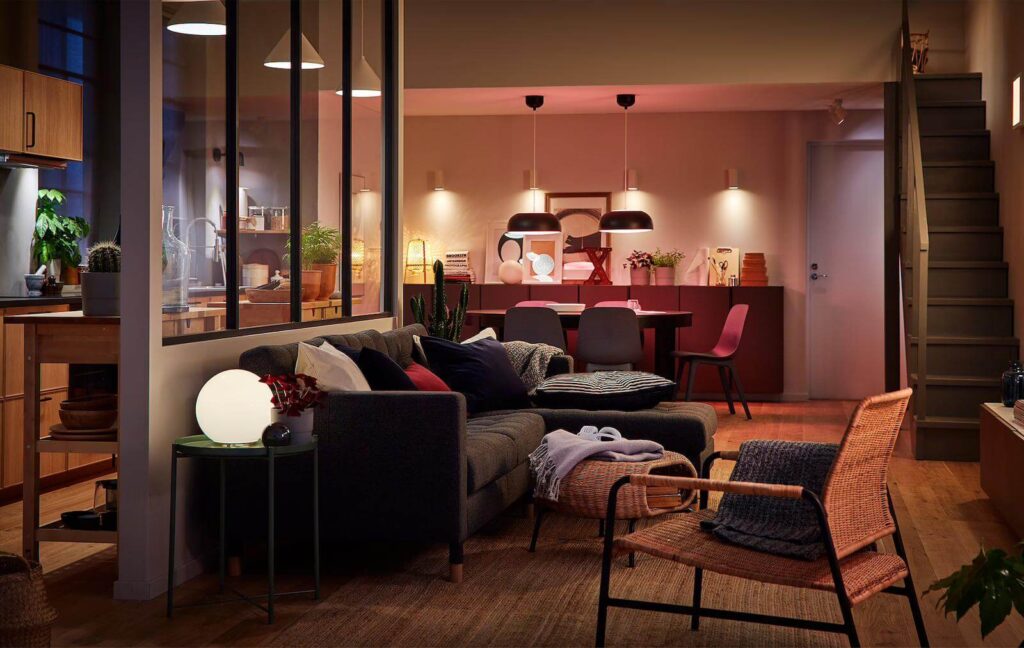
E. The Impact of 6000K Lighting on Productivity and Safety
6000K lighting plays a significant role in enhancing productivity and safety in various settings. Its bright, cool tones keep individuals alert and focused, making it an invaluable tool in workspaces where efficiency and attention to detail are paramount. For example, in industrial settings, 6000K lighting improves visibility, reduces errors, and helps workers remain attentive during long shifts, contributing to higher productivity levels.
Moreover, in terms of safety, 6000K lighting is crucial in environments where clear visibility can prevent accidents or injuries. In garages or workshops, where the use of sharp tools or heavy machinery is common, proper lighting is essential for reducing the risk of mishaps. The clarity provided by 6000K bulbs ensures that every movement is visible, and potential hazards are easier to detect.
In outdoor settings, the bright, crisp light of 6000K bulbs enhances security and safety by improving visibility in areas that would otherwise be dark or poorly lit. This makes it easier for pedestrians, drivers, and security personnel to navigate spaces safely while also deterring potential security threats.
In conclusion, while 6000K lighting may not be ideal for every room in the home, its ability to enhance focus, visibility, and safety makes it indispensable in task-oriented or industrial environments. Whether used in workshops, garages, basements, or outdoor spaces, 6000K lighting offers significant advantages in terms of productivity and security, ensuring that every detail is visible and every task is performed with precision.
Выбор правильного освещения для вашего дома
Lighting plays a critical role in shaping the ambiance, functionality, and energy efficiency of your home. By selecting the right lighting temperature, you can create an atmosphere that suits each room’s specific needs. Here’s an in-depth look at the factors that influence lighting choices and some strategies to experiment with different color temperatures.
A. Factors Influencing the Choice of Lighting Temperature
1. Room Purpose The primary factor in choosing the right lighting temperature is the purpose of the room. Every space in your home serves a different function, and lighting should complement those functions:
- Living rooms and bedrooms often benefit from warmer lighting (around 3000K), which creates a cozy, relaxing atmosphere conducive to unwinding after a long day.
- Kitchens and home offices require brighter, cooler lighting (4000K) for clarity and focus, making it easier to work or prepare meals with precision.
- Bathrooms often need a combination of lighting. For instance, cool lighting near mirrors helps with grooming, while softer lighting elsewhere maintains a relaxing ambiance.
- Garages and basements may require the brightest and coolest lighting, such as 6000K, to ensure visibility during detailed tasks like car repairs or crafts.
Matching the lighting temperature to the room’s specific purpose ensures both comfort and efficiency in everyday tasks.
2. Desired Ambiance Lighting temperature significantly impacts the ambiance of a room. A warm color temperature (3000K or lower) creates an inviting, intimate mood, ideal for spaces like living rooms, bedrooms, or dining areas where comfort is prioritized. Conversely, cooler color temperatures (4000K and higher) offer a cleaner, more energetic atmosphere that works well in areas where productivity is key, such as home offices or kitchens. The choice of lighting color directly affects how a room feels—soft and relaxing or bright and energizing.
3. Energy Efficiency Energy efficiency is another essential consideration when choosing lighting. LED lights are a top choice for energy savings because they use significantly less power than traditional incandescent bulbs. When choosing lighting temperatures, consider that cooler lighting options tend to be slightly more energy-efficient than warmer ones due to their composition. That said, the difference is minimal, and personal preference often outweighs this slight energy advantage. LED lights, in general, provide a balance between energy conservation and long-term cost savings, as they have a longer lifespan than other types of bulbs.

B. The Role of Personal Preference in Lighting Selection
While functionality and ambiance are crucial, personal preference plays a substantial role in lighting choices. Everyone has different sensitivities to light. For instance, some people may find cooler lighting (4000K to 6000K) too harsh for residential spaces, preferring the soft warmth of 3000K lighting, even in task-heavy rooms like kitchens or offices. Likewise, those who prefer a minimalist, modern aesthetic might opt for the cleaner look of cool lighting in their living spaces, despite the traditional suggestion of warmer tones. Personal taste, comfort, and the overall style of your home are key to finalizing your lighting decisions.
C. Strategies for Experimenting with Different Color Temperatures
When determining the best lighting temperature for your home, it’s essential to experiment with various options. Here are some strategies to find what works best:
- Use dimmable LED bulbs: Dimmable lights allow you to change the intensity of lighting to suit different moods and tasks. They also provide a way to shift between cooler and warmer tones if you select tunable LED lights, offering greater flexibility in a single fixture.
- Try adjustable or tunable LEDs: Some modern LED fixtures allow you to adjust the color temperature itself, switching between warmer, neutral, or cooler tones. This is ideal for spaces that serve multiple purposes, such as a home office that also functions as a relaxation area in the evening.
- Test lighting in different rooms: Since lighting impacts mood and functionality, try placing bulbs with different color temperatures in various rooms. For example, start with warm lighting in your living room and cooler lighting in your bathroom or kitchen. Over time, observe how these temperatures affect your comfort and productivity in each space.
- Consider layering your lighting: Layered lighting, which includes ambient, task, and accent lighting, allows you to blend different color temperatures to create a more dynamic and versatile space. For instance, you might use warm lighting for ambient light but cooler task lighting in work zones, giving you the best of both worlds.
The Impact of Lighting on Mood and Health
Lighting is not just a matter of aesthetics and functionality; it plays a significant role in influencing our mood, energy levels, and overall health. The right lighting can improve focus and productivity, while the wrong kind can disrupt sleep and elevate stress. This article explores how different lighting temperatures affect the body, focusing on their impact on melatonin and serotonin levels, the importance of maintaining a healthy sleep-wake cycle, and how to design a lighting scheme that supports physical well-being.
A. How Different Lighting Temperatures Affect Melatonin and Serotonin Levels
Lighting temperature is more than a visual choice; it directly impacts the body’s biochemical processes. The two key hormones influenced by light exposure are melatonin and serotonin, which regulate sleep and mood.
- Melatonin is the hormone responsible for regulating the sleep-wake cycle. It is primarily produced in darkness, encouraging a state of relaxation and promoting sleep. Exposure to warmer, lower-temperature lighting (such as 3000K and below) can stimulate melatonin production, helping individuals feel drowsy and ready for rest. This is why warm lighting is often recommended in bedrooms and living spaces where relaxation is a priority.
- Serotonin, с другой стороны, это гормон, который способствует ощущению благополучия, счастья и энергии. Воздействие более прохладного, более температурного освещения (4000K и выше) имитирует дневной свет, что способствует производству серотонина. Это может помочь повысить бдительность, концентрацию и общее настроение, что делает более прохладное освещение идеальным для среды, где необходима производительность, например, офисы, кухни и рабочие пространства.
The spectrum of lighting temperatures can thus either enhance relaxation or promote alertness. Warmer light (3000K) encourages melatonin production, aiding in relaxation and sleep, while cooler light (4000K to 6000K) boosts serotonin, making you more alert and energized. The careful use of these lighting temperatures can significantly impact how you feel and perform throughout the day.
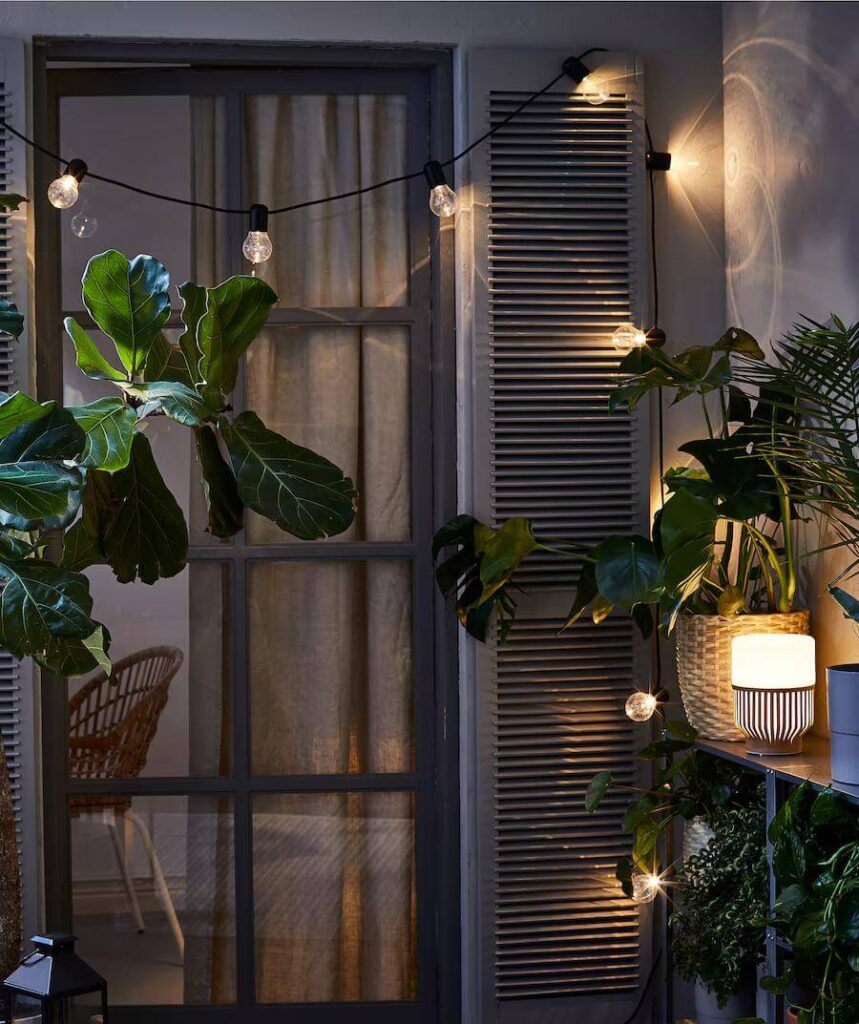
B. The Importance of a Healthy Sleep-Wake Cycle and Its Relation to Lighting
The sleep-wake cycle, or circadian rhythm, is one of the most critical bodily functions influenced by light. This internal clock helps regulate when we feel awake and when we become tired, in sync with natural daylight. In today’s modern world, artificial lighting has a significant influence on this cycle, and improper lighting can lead to disruptions.
When we are exposed to bright, cool light (6000K and above) late in the evening, it can delay the production of melatonin, making it harder to fall asleep and negatively affecting the quality of rest. This is because the brain interprets cooler lighting as daylight, which signals the body to stay alert. Over time, this disruption can lead to insomnia, fatigue, and even mood disorders like depression and anxiety.
Conversely, inadequate lighting during the day—especially if you’re working indoors in dim lighting—can fail to stimulate serotonin production. Without adequate exposure to bright, cool light, your body may struggle to stay alert and energized, further disrupting the sleep-wake cycle. In extreme cases, insufficient lighting exposure can lead to Seasonal Affective Disorder (SAD), a form of depression related to low light exposure during certain seasons.
Creating a lighting environment that aligns with your circadian rhythm is crucial for maintaining a healthy sleep-wake cycle. The key is to mimic the natural light patterns we experience outdoors: cooler, brighter lighting during the day and softer, warmer lighting as the evening progresses.
C. Tips for Creating a Lighting Scheme That Supports Physical Well-Being
Given the powerful impact of lighting on mood and health, it is essential to create a lighting scheme that supports both your mental and physical well-being. Here are some tips to optimize lighting for health:
1. Use Natural Light Whenever Possible
Natural sunlight is the most effective way to regulate your circadian rhythm and promote overall well-being. Try to let in as much daylight as possible, especially in the morning. Open curtains and blinds to flood your space with natural light, and consider working near windows to maximize exposure. If natural light is limited, consider investing in light therapy lamps designed to mimic daylight.
2. Incorporate Layered Lighting
A well-designed lighting scheme uses layers: ambient, task, and accent lighting. This approach allows you to use different lighting temperatures throughout the day to suit your needs:
- Ambient lighting provides overall illumination and can be set to warmer tones in the evening to promote relaxation.
- Task lighting in workspaces should be cooler (4000K to 6000K), ensuring that you can focus without strain. Adjustable or tunable lighting that shifts between warm and cool temperatures throughout the day is ideal for offices or study areas.
- Accent lighting can be used to enhance the ambiance of a room, with dimmer controls allowing you to switch between different lighting temperatures as needed.
3. Use Dimmable or Tunable LEDs
Invest in dimmable or tunable LED lights that allow you to adjust the brightness and color temperature according to the time of day. Dimmable LEDs are particularly useful in the evening, as they help create a calming environment by reducing brightness and transitioning to warmer tones, which encourage melatonin production. Tunable LEDs are even more versatile, allowing you to shift from energizing daylight-like lighting in the morning to softer, relaxing hues in the evening.
4. Avoid Exposure to Cool Lighting Before Bed
As bedtime approaches, it is essential to reduce exposure to cooler, blue-toned lighting. This includes screens from smartphones, computers, and TVs, as well as bright overhead lighting. Instead, opt for dimmed, warm lighting (3000K or lower) in your living spaces and bedroom to encourage melatonin production and prepare your body for sleep.
5. Consider Circadian Lighting Solutions
Some advanced lighting systems are designed to simulate the natural progression of daylight. These circadian lighting solutions automatically adjust the color temperature and brightness of your lights throughout the day, supporting your natural rhythm. While these systems can be more expensive, they are ideal for those seeking a health-focused lighting scheme.
The impact of lighting on mood and health is profound. By understanding how different lighting temperatures influence hormones like melatonin and serotonin, and by designing a lighting scheme that aligns with your circadian rhythm, you can enhance your physical well-being. Whether through natural light, layered lighting, or smart lighting solutions, the right choices can help improve sleep, focus, and overall health.
Practical Applications and Tips
Lighting is one of the most versatile tools in home design, with the power to alter mood, enhance functionality, and elevate aesthetics. Beyond simply illuminating a space, thoughtful lighting design incorporates a variety of techniques to create environments that serve practical needs while promoting comfort and visual interest. This section will explore practical applications of lighting across different rooms, techniques for layering lighting, and how dimming and smart technologies enhance flexibility and energy efficiency.
A. Case Studies of Effective Lighting in Different Types of Rooms
1. Living Room: Creating a Cozy and Functional Space The living room is a multifunctional space where people relax, entertain, and sometimes work. As such, the lighting needs to cater to a variety of activities, blending both style and practicality. In one case, a designer used a combination of warm, ambient lighting from overhead chandeliers, combined with task lighting from table lamps, to create a cozy yet functional environment. The room also featured accent lighting in the form of LED strip lights behind shelving units, illuminating art and decor.
In this setup, the designer achieved a balance between atmosphere and functionality. The warm, 3000K lighting provided comfort, while the layered approach ensured that there was adequate illumination for reading or entertaining guests. The dimming options allowed the homeowners to shift between bright, functional lighting during gatherings and a softer, more intimate ambiance during movie nights.
2. Kitchen: Balancing Task Lighting and Aesthetics The kitchen requires clear, bright lighting for food preparation, but it also benefits from softer lighting for dining or socializing. One case study highlights a modern kitchen where the designer incorporated a mix of overhead recessed lighting in a cool 4000K temperature, perfect for task work, and pendant lights over the kitchen island for ambient and decorative purposes. Under-cabinet lighting was also used to illuminate countertops, providing practical task lighting without the need for harsh overhead lights.
This design allowed for different lighting levels based on the time of day and the activity at hand. In the morning, bright task lighting made the kitchen feel energized and functional, while in the evening, dimming the pendant lights and under-cabinet LEDs created a more relaxed and welcoming atmosphere for dinner or casual conversation.
3. Bedroom: Enhancing Relaxation and Sleep Quality Bedrooms are spaces of rest, and the lighting should reflect that. In one effective lighting scheme, a combination of warm ambient light (2700K) from bedside table lamps, supplemented with adjustable recessed lights, allowed the homeowners to control the lighting based on their needs. The recessed lights provided brighter light for activities like reading, while the warm table lamps promoted relaxation and melatonin production before bedtime.
This flexible lighting setup proved effective in promoting a restful environment, as the dimmable features allowed for easy transitions from evening relaxation to morning routines. The use of warm light throughout the room fostered a sense of calm, ensuring that the space was conducive to sleep.
B. Techniques for Layering Lighting to Create Depth and Interest
Layering lighting is a technique used to enhance the depth and visual interest of a room by combining different types of lighting: ambient, task, and accent lighting.
1. Ambient Lighting This is the primary source of light in a room, usually provided by overhead fixtures like chandeliers, recessed lights, or ceiling-mounted fixtures. Ambient lighting ensures that the room is evenly lit and safe to move through. While functional, ambient lighting can be softened through the use of dimmable switches, allowing for more intimate settings as needed.
2. Task Lighting Task lighting is focused lighting meant to illuminate specific areas where detailed activities are performed, such as reading, cooking, or working. Common task lights include desk lamps, pendant lights, or under-cabinet lights in the kitchen. For example, in home offices or kitchens, a cool 4000K or higher temperature lighting is used to promote focus and visibility, while warmer lights are preferred for relaxation areas like living rooms or bedrooms.
3. Accent Lighting Accent lighting serves a decorative purpose, drawing attention to specific features in a room, such as art, architectural details, or bookshelves. This lighting is usually more directional and less intense than task lighting. LED strip lights, sconces, and track lighting are popular choices for accent lighting. By adding these focal points, accent lighting creates a sense of depth and visual interest, transforming the space from flat and functional to dynamic and engaging.
A good example of layering lighting is a living room that incorporates all three types. Overhead ambient lights provide general illumination, table lamps or floor lamps offer focused task lighting, and accent lighting highlights art or plants. Together, this layered approach creates a dynamic and versatile space where homeowners can adjust the lighting to suit any mood or occasion.
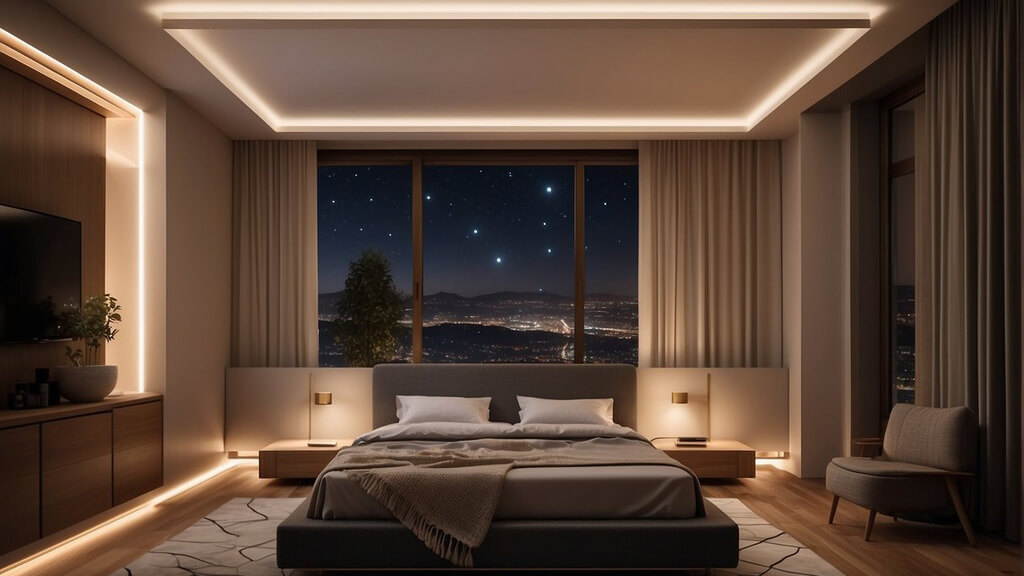
C. The Benefits of Dimming and Smart Lighting Technologies
1. Flexibility in Lighting Control Dimming technology offers immense flexibility, allowing you to adjust the brightness of your lights based on the time of day or the activity. Whether you’re winding down after dinner or hosting a vibrant gathering, the ability to dim lights helps you set the right tone. For example, dimming down 4000K task lighting in the kitchen after cooking turns the space into a cozy social zone without needing to switch fixtures. Similarly, in the bedroom, dimming lights down to a warmer, softer glow can signal your body to start relaxing and preparing for sleep.
Dimming also enhances energy efficiency. By lowering the intensity of the lights, you consume less electricity, which can extend the life of your light bulbs. This is especially beneficial for LED lighting, which already consumes less energy than traditional incandescent bulbs.
2. Smart Lighting Technologies Smart lighting takes flexibility a step further, offering advanced control through automation, mobile apps, and voice commands. With smart bulbs, you can schedule lighting changes based on your daily routine, such as gradually brightening lights in the morning to simulate sunrise or dimming them in the evening to promote relaxation. Smart systems allow you to adjust color temperatures as well, switching between cooler tones for morning energy and warmer hues for evening comfort.
For instance, smart lighting in a home office can be set to 5000K during working hours to improve focus, and later shift to 3000K in the living room for relaxation. Many smart lighting systems are also compatible with home automation devices like Alexa or Google Home, enabling hands-free control. The convenience and customization of smart lighting help create spaces tailored to both your practical needs and your well-being.
3. Energy Efficiency Both dimming and smart lighting technologies contribute to energy savings. By using only the amount of light you need at any given moment, you reduce energy waste, ultimately lowering your utility bills. Furthermore, smart lighting systems often come with motion sensors or occupancy detectors, ensuring that lights turn off automatically when a room is not in use. This adds an extra layer of efficiency, making your home eco-friendlier while extending the lifespan of your bulbs.
The thoughtful application of lighting can transform a room, making it more functional, inviting, and energy-efficient. By exploring case studies of effective lighting design, implementing layered lighting for depth, and integrating dimming and smart technologies, homeowners can create versatile spaces that cater to both mood and practicality. Whether it’s achieving the perfect ambiance for relaxation or boosting productivity, lighting has the power to significantly impact both the aesthetics and functionality of your home.
Заключение
Choosing the right lighting temperature is essential for creating a comfortable and functional living environment. The appropriate lighting not only enhances the aesthetic appeal of a room but also impacts mood, productivity, and even health. As explored, different lighting temperatures—from the warm glow of 3000K to the cooler brightness of 6000K—offer distinct benefits depending on how they are applied. Warm lighting is ideal for relaxation and unwinding, while cooler lighting boosts alertness and focus, making it perfect for task-oriented spaces. Ultimately, selecting the right temperature is crucial for ensuring that your home feels both inviting and practical.
A key factor in selecting lighting is to consider the purpose of the room and the mood you want to evoke. A living room, designed for comfort and social interaction, will benefit from warmer, softer lighting, creating a cozy atmosphere. Conversely, a home office or kitchen, where clarity and precision are required, needs cooler, brighter lighting to keep energy levels high. By aligning the lighting temperature with the room’s intended function, you can ensure that the space meets both practical and emotional needs.
Achieving the perfect lighting balance involves more than just choosing a single fixture or temperature. As highlighted, layering different types of lighting—ambient, task, and accent—creates a more dynamic, functional, and visually engaging space. Moreover, incorporating dimming and smart lighting technologies allows for flexibility, enabling you to adjust brightness and color temperature to suit various activities and moods throughout the day.
In conclusion, lighting is a powerful tool that, when thoughtfully chosen, can transform your home. By carefully considering each room’s purpose and desired ambiance, and utilizing the flexibility of modern lighting technologies, you can create spaces that are both beautiful and perfectly suited to your lifestyle.
Buy Purchase LED lights from LEDAPLUS
When it comes to selecting the right lighting for your home or business, LEDAPLUS Lighting Manufacturer provides a wide range of high-quality LED lighting solutions designed to meet various needs and preferences. Whether you’re looking for warm, ambient lighting to create a cozy atmosphere or bright, cool lighting for task-oriented spaces, LEDAPLUS has you covered. With a commitment to energy efficiency and sustainability, their LED lights are not only environmentally friendly but also cost-effective, offering long-term savings on energy bills.
LEDAPLUS offers a broad selection of lighting options, including downlights, track lights, spotlights, and panel lights. Each product is designed with versatility and durability in mind, allowing you to find the perfect lighting solution for any room in your home or office. Their range of color temperatures ensures that you can create the desired ambiance and functionality in every space.
At the heart of LEDAPLUS’s mission is customer satisfaction. They prioritize understanding the unique needs of their customers and offering personalized guidance to help you choose the best lighting options. If you have any inquiries or require assistance, their dedicated customer service team is ready to provide expert advice and support, ensuring a seamless and satisfying experience.

